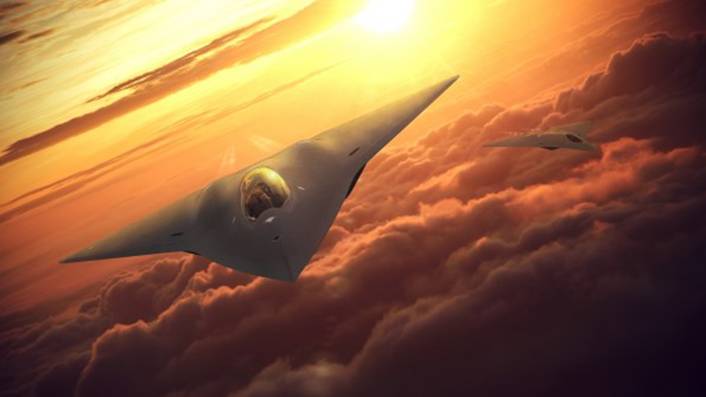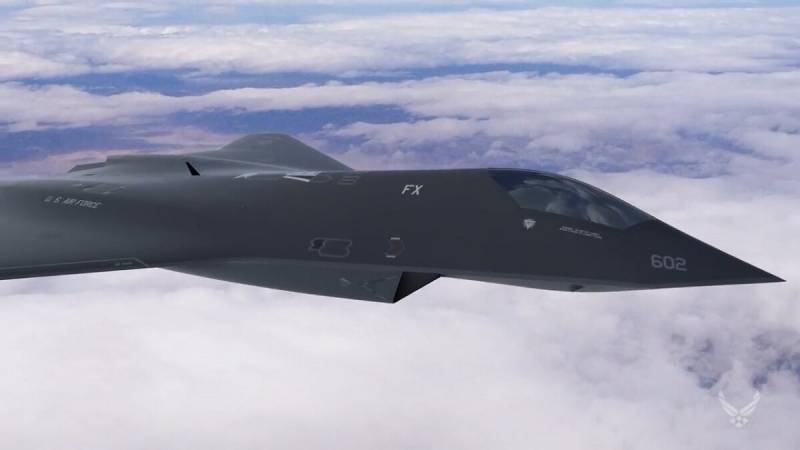NGAD Review: Five-Year Fighter
Digital Hundredth Series
New plans for the NGAD project a few days ago were announced by Deputy Air Force Procurement Minister Will Roper in an interview for Defense News. The topic of the interview was the process of further development of US tactical aviation, primarily the NGAD project and its prospects. It turned out that already in October, the Air Force intend to revise this program in order to optimize all the main processes.
To date, the development of the NGAD fighter complex is proceeding in accordance with the Air Superiority 2030 study, released in 2016. It proposed the creation of an inconspicuous Penetrating Counter Air fighter capable of becoming the central element of a more complex complex. The PAC aircraft must work together with ground and air detection systems, drones etc. A fighter of this kind was planned to be created and put into service in the early thirties.
In recent studies, such NGAD implementation principles were deemed unprofitable. The development of the proposed aircraft is too complicated, expensive and time-consuming. There are also some problems associated with the activities of the likely adversary.
Not so long ago, the leadership of the NGAD program changed, and new officials intend to seriously restructure it from October 1. Now an accelerated methodology for creating advanced aviation technology is being proposed. It provides for the rapid development of the aircraft with the highest possible characteristics at the moment. Ideally, this will allow you to create a new car almost every five years.
The proposed approach resembles the development of the so-called “Honeycomb series” - a series of tactical aircraft from the fifties of the last century. They were created simultaneously with the widespread use of common technologies, although the result was different. New samples that should appear on the results of NGAD, W. Roper calls the "Digital hundredth series" - alluding to the use of modern design techniques.
Five-year fighter
The current approach to the creation of aviation technology involves long-term R&D, which results in the appearance of an aircraft with the highest possible characteristics. At the same time, all this requires a lot of time and leads to an increase in the cost of the program. After revising the NGAD program, it is planned to create a whole series of aircraft with an acceptable price-performance ratio.
In just a few years, the Air Force and industry will have to create a promising fighter, built on an affordable base and having the maximum possible characteristics for a given time. Such a machine will go into a limited series, and engineers will create a more advanced model on a production platform. W. Roper pointed out that with the modern development of technology, this will make it possible to produce a new aircraft approximately once every five years.
As a result, over a long period, the Digital Hundredth Series will be created - a whole family of unified next-generation fighters with different capabilities and tasks. The family will have airplanes of familiar appearance, carriers weapons on new principles, specialized reconnaissance vehicles, drones, etc. All of these samples can be combined into a network-centric structure for joint combat missions.
Project Basics
It is proposed to accelerate the design and launch of production through a number of important proposals. The first involves the maximum use of digital design systems at all stages. W. Roper complained that not all US defense enterprises pay due attention to this issue. However, those factories that have introduced modern technology show remarkable results.
The second sentence concerns the open architecture of the aircraft. NGAD should implement not only the usual plug-and-play principle, but also be a fully modular and open system. It is necessary to ensure the free replacement of equipment and components, as well as simplify the development of software by third-party contractors as much as possible.
Finally, it is necessary to increase the flexibility of software development, on which the combat qualities of technology directly depend. It is necessary to accelerate the process of development, testing and implementation of software, as well as involve the operator in all the main processes.
The exact plan for the updated NGAD program has not yet been determined. At the same time, W. Roper revealed the expected features of the process of development and construction of equipment. In this regard, the program will be divided into several stages.
Work will begin with contracts with two or more aircraft developers. Then all of them will present their versions of NGAD in digital form, which will simplify the study and comparison of projects. The creator of the most successful project will receive a contract for a small series, from 24 to 72 units. In parallel with the launch of production of such an aircraft, a new machine will be developed, which will be put into series later.
To simplify and reduce the cost of the development of the Air Force, they can consciously reduce the required resource for aircraft construction. This will require faster replacement, but the Digital Hundredth Series should ensure timely fleet renewal.
Advantages and disadvantages
The main advantage of the new approach to NGAD is the possibility of accelerated creation of an aircraft with the characteristics at the limit of available technologies. Then the Air Force will be able to supplement or replace it with a new fighter with new capabilities and enhanced characteristics.

Lockheed Martin's NGAD variant
Speeding up design and production will reduce planning horizons with certain benefits. Now the Air Force will not have to formulate requirements for technology with an eye on the next few decades.
A new approach can be a problem for potential opponents. They will have to constantly monitor new US developments and take timely action. Every few years they will be forced to evaluate a new American model and look for ways to counter it. According to W. Roper, the United States will always have in stock a new aircraft with new capabilities. This will force third countries to "play on the terms of the US Air Force."
However, the proposed "Digital Hundredth Series" has significant drawbacks. First of all, this is the need for a fundamental restructuring of all processes and methods for developing aviation technology. At this stage, the Air Force and contractors may face the most serious organizational and financial problems.
Plans to build an airplane every five years can be overly bold. The development of the basic NGAD platform, despite the new approaches, will continue until the beginning of the thirties. Its modernization by replacing individual devices and systems will be faster, but there is no guarantee that these processes can be put into the indicated five years.
As part of NGAD, it is proposed to develop a whole aviation complex, including not only the next-generation fighter. Each element of such a complex requires a separate R&D, which imposes new requirements in terms of time. Even the gradual development and implementation of new technologies does not guarantee the receipt of all the desired results with a reasonable cost and within an acceptable time frame.
Challenging Perspective
The proposed methods for the further development of tactical aviation are of interest and may have a great future. The advantages of such a concept are convincing, but one cannot ignore the expected disadvantages. Thus, the Air Force should carefully study new approaches to development and determine their real prospects in the light of the existing capabilities of the industry and its further development.
The Ministry of the Air Force became interested in the original proposal and in the near future will begin to study it with an eye to real application. He also found supporters in Congress, although lawmakers have not yet decided on their opinions. The use of new methods can make the NGAD project one of the most daring and successful in the future. stories American aviation. However, a negative outcome cannot yet be ruled out.

Information